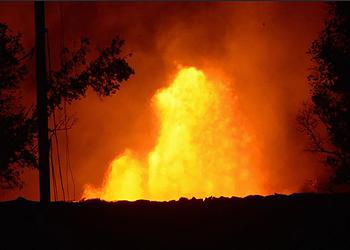
MANCHESTER, UK, June 7, 2018 (ENS) – British scientists are using the latest in 4D technology to predict the behavior of lava flows and what that means for volcanic eruptions.
The findings explain why some lava flows move slowly yet others can cover kilometers in just a few hours, highlighting the hazard posed by fast-moving flows that often pose the greatest danger to people living close to volcanoes.

The research, led by the University of Manchester, is studying the processes which happen during crystallization in basaltic magmas using 4D synchrotron X-ray microtomography.
It is the first time this kind of 4D scanning technology has been used for investigating crystallization during volcanic eruptions and for simulating the behavior of a natural lava flow. The study was published in the journal “Nature Scientific Reports.”
3D scans show still pictures in three dimensions, while 4D scans show moving 3D images, with time being the fourth dimension
Led by Professor Mike Burton, Chair of Volcanology at the University, the research team monitored crystallization in magmas, a fundamental process that drives eruptions and controls different kinds of volcanic activity.
Using this novel approach and technology they can, for the first time, watch the crystals grow in 3D in real-time, simulating the behavior of lava flows once a volcano has erupted.
The process is similar to scenes witnessed at the eruption of the Kilauea Volcano in Hawaii.

“During volcanic eruptions small crystals grow within magma. These crystals can greatly change the way magma flows,” Burton explains. “Simply put, the more crystals there are the slower the eruption will be which also reduces the speed and distance travelled by lava flows.”
“The fewer crystals present in the lava means the eruption will speed up, potentially becoming more powerful and devastating. Our research and this new approach open an entirely new frontier in the study of volcanic processes.”
To study the rate of crystal growth the team set up a sample from a real eruption in a high temperature cell, before performing X-ray CAT scans while controlling the temperature of the magma.
This allowed the team to visualize the formation and growth of crystals, and measure how quickly they grew.
Using this method and technology researchers can collect hundreds of 3D images during a single experiment. This data is then used in complex, numerical models to fully characterize the behavior of volcanic eruptions more accurately.
Dr. Margherita Polacci from Manchester’s School of Earth and Environmental Sciences, the study’s lead author, said, “Being able to more accurately predict the behavior of lava flows could also allow us to help relevant safety agencies devise and develop new safety strategies and actions when dealing with eruptions in populated areas.”
This isn’t the only use for such technology in geosciences. A 2017 study shows it has been used to investigate: (i) high temperature, observing in situ oil shale pyrolysis; (ii) low temperature, replicating the generation of permafrost; (iii) high pressure, to study the invasion of supercritical CO2 in deep aquifers; (iv) uniaxial stress, to monitor the closure of a fracture filled with sand in shale; (v) reactive flow, to observe the evolution of the hydraulic properties in a porous rock subject to dissolution.
Burton said, “There are many more applications of this approach in materials science, mineral extraction and other geological processes. We are very excited about the prospect of extending our studies to high pressures, which we will be doing in further experiments in 2018.”
Copyright Environment News Service (ENS) 2018. All rights reserved.
